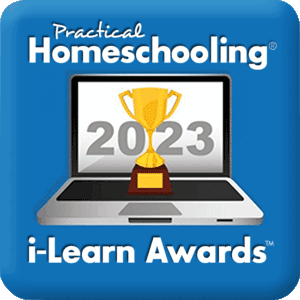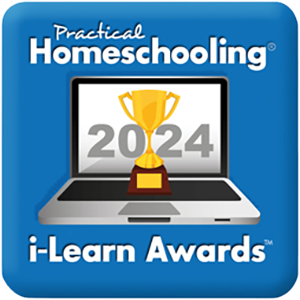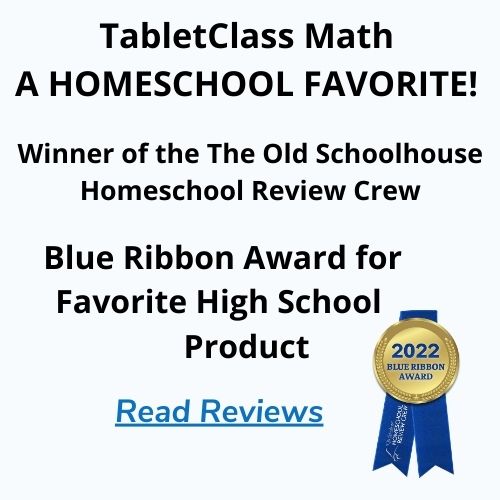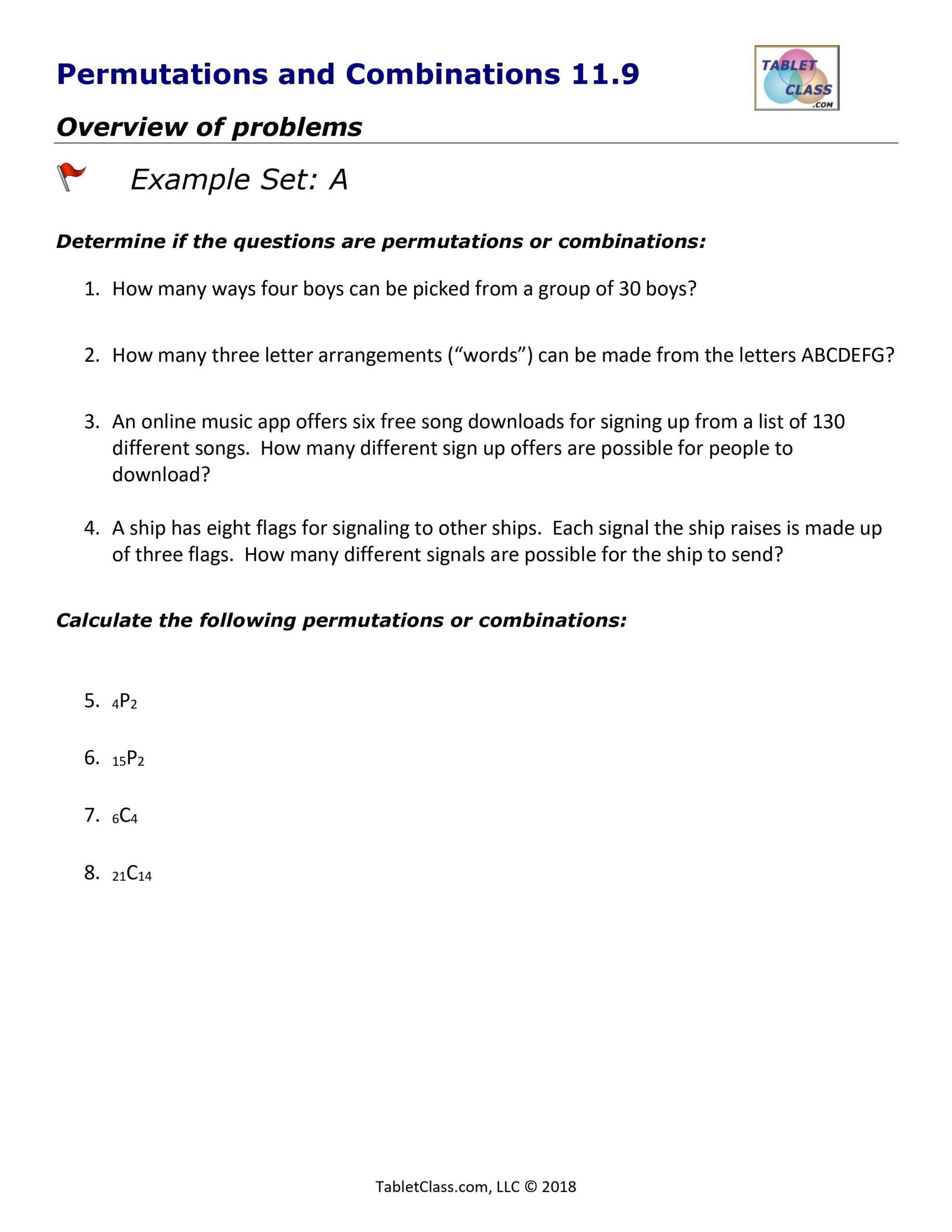“TabletClass Math has given my daughter the confidence to excel in areas she was not doing so before. She has personally said that she likes the set up of the class, how he gives the objectives before the lesson and reviews afterwards to make sure she gets what was taught. ”
“TabletClass Math has given my daughter the confidence to excel in areas she was not doing so before. She has personally said that she likes the set up of the class, how he gives the objectives before the lesson and reviews afterwards to make sure she gets what was taught.”




TabletClass Math makes homeschooling Precalculus easy. We include the right amount of instruction your child needs to excel.
Our teacher, John Zimmerman, cares about your child’s success. He guides students every step of the curriculum with clear and understandable instruction that will help build their confidence in math.
Homeschool Precalculus Curriculum Summary
The homeschool Precalculus curriculum is designed as a high school third year or fourth year college prep math course. The goal of the precalculus course is to prepare students for college level mathematics, especially Calculus. A strong foundation in the concepts and skills of Algebra 2 is required, as well as a graphing calculator like a TI-83 or TI-84.
Precalculus is a demanding course even for strong math students – extra commitment and dedication will be required to do well in this course, as the concepts are far more advanced than Algebra 2.
The first part of the precalculus curriculum is an extensive series of sections on algebra topics that students should have mastered in Algebra 2. Also, new advanced concepts will be introduced in the area of function analysis and rational functions.
Part 2 of the curriculum focuses on Trigonometry to include many of the advanced topics a student will need to be prepared for Calculus. The chapters on Trigonometry are equivalent to a stand-alone Trigonometry course.
The last part of the homeschool precalculus curriculum covers other advanced math topics to include conic sections, matrices and determinants, systems, partial fractions, sequence, and series and probability.
-Lisa S.
Chapters
Sections
Videos
Chapters
Sections
Videos
Chapter 1: Linear Functions – Equations and Inequalities (Optional Review)
This chapter reviews many of the fundamental algebra skills that students should have mastered in Algebra 1 and Algebra 2. Students are encouraged to take the time to go over these sections to ensure they are ready for the more advanced concepts later in the course.
Sections:
- 1.1 One Step Equations
- 1.2 Solving Two Step Equations
- 1.3 Solving Multi-Step Equations
- 1.4 Formulas and Literal Equations
- 1.5 Linear Inequalities
- 1.6 Compound Inequalities
- 1.7 Introduction to Absolute Value
- 1.8 Solving Absolute Value Equations
- 1.9 Absolute Value Inequalities
- 1.10 Graphing Absolute Value Equations
- 1.11 Graphing Lines with One Variable
- 1.12 Graphing Lines with Two Variables
- 1.13 The Slope of a Line
- 1.14 Slope Intercept Method
- 1.15 XY Intercept Method
- 1.16 Writing the Equations of Lines -Using Slope-Intercept Form
- 1.17 Writing the Equations of Lines -Using Point-Slope intercept
- 1.18 Writing the Equations of Lines -Given the Slope and a Point
- 1.19 Writing the Equations of Lines -Given Two Points
- 1.20 Standard Form of Linear Equations
- 1.21 Best Fitting Lines and Scatter Plots
- 1.22 Linear Models/Word Problems
- 1.23 Graphing Linear Inequalities in Two Variables
Chapter 2: Relations, Functions and Graphs
Functions and relations transcend all through mathematics. The first part of this chapter reviews core concepts at the Algebra 1/2 level. The second part of this chapter covers more advanced study of the topic of functions and relations. Time is taken to explain the difference between a function and relation and introduce the student to the language of functions to include the domain, range and linear/nonlinear functions.
Students will also learn function operations, composite functions and graphing. Lastly, students will learn how to transform functions as well as doing a detailed analysis of the domain and range of functions.
Sections:
- 2.1 Introduction to Functions and Relations
- 2.2 Function Operations
- 2.3 Inverse Functions
- 2.4 Graphing Functions
- 2.5 Linear and Nonlinear Functions
- 2.6 Special Functions
- 2.7 Composite Functions
- 2.8 Interval and Set Builder Notation
- 2.9 Function Symmetry
- 2.10 Transformations of Functions
- 2.11 Function and Relation Analysis (Finding Domain/Range)
Chapter 3: Polynomial and Rational Functions
The first part of the chapter reviews all the concepts and skills to solve second-degree polynomials which are quadratic functions. Next, the student will learn advanced techniques and concepts to solve a polynomial equation of any degree. Lastly, the chapter covers rational functions to include graphing a rational function and solving a rational inequality.
Sections:
- 3.1 Introduction to Quadratic Equations
- 3.2 Solving Quadratic Equations by Square Roots
- 3.3 Graphing Quadratic Equations
- 3.4 The Quadratic Formula
- 3.5 Solving Quadratic Equations by Factoring
- 3.6 The Discriminant – Types of Roots
- 3.7 Completing the Square
- 3.8 Quadratic Equation Word Problems
- 3.9 Graphing Quadratic Inequalities
- 3.10 Complex and Imaginary Numbers
- 3.11 Graphing Polynomials
- 3.12 Solving Polynomial Equations by Factoring
- 3.13 Polynomial Division (Long and Synthetic Division)
- 3.14 Remainder and Factor Theorem
- 3.15 Rational Root Theorem (Rational-Zero Test)
- 3.16 Solving n-degree Polynomials (Fundamental Theorem of Algebra)
- 3.17 Descartes’ Rule of Signs and Bounds
- 3.18 Graphing Rational Functions (Vertical and Horizontal Asymptotes)
- 3.19 Rational Inequalities
Chapter 4: Logarithmic and Exponential Functions
For most students this chapter will be their first introduction to logarithms. As such the chapter focuses on teaching the basic core concepts of a logarithm and its relationship to an exponential function. Students will learn how to covert between a logarithm/exponential equation.
Additionally, the chapter defines the properties of logarithms and how to condense and expand logarithmic expressions. The Natural Base e and Natural logarithms are explored with explanations of how to use the “log and ln” functions on a scientific calculator. Finally, the chapter covers the methods and procedure to solve exponential and logarithmic equations.
Sections:
- 4.1 Exponential Growth and Decay Functions
- 4.2 Introduction to Logarithms
- 4.3 Properties of Logarithms
- 4.4 The Natural Base e
- 4.5 Natural Logarithms
- 4.6 Solving Logarithmic Equations
- 4.7 Solving Exponential Equations
Chapter 5: Trigonometric Functions
This very important chapter introduces the student to advanced trigonometry. Concepts involving the trigonometric ratios, sin, cos, tan, radians are explored. Next, the chapter focuses on evaluating trigonometric functions and finding the inverse of a trigonometric function. Lastly, students learn to graph sin, cos, tan, csc, sec, and cot graphs. Special note: students will need their graphing calculators for the chapter practice problems.
Sections:
- 5.1 Trigonometric Ratios
- 5.2 Angles of Rotation and Radian Measure
- 5.3 Evaluating Trigonometric Functions
- 5.4 Inverse Trigonometric Functions
- 5.5 Graphs of Sine and Cosine Functions
- 5.6 Graphs of Other Trigonometric Functions
Chapter 6: Trigonometric Identities and Equations
This chapter continues to explore more topics in trigonometry – the focus of this chapter is trigonometric identities. Students will learn how to use and verify trigonometric identities.
Students will also learn how to solve a trigonometric equation. A wide of variety of trigonometric identities will be covered to include the fundamental identities, sum and difference, double and half angle, and product and sum identities.
Sections:
- 6.1 Trigonometric Identities
- 6.2 Solving Trigonometric Equations
- 6.3 Sum and Difference Identities
- 6.4 Double-Angle and Half-Angle Identities
- 6.5 Product and Sum Identities
Chapter 7: Applications of Trigonometry
This chapter explores many applications of trigonometry at an advanced level. Students will learn how to solve non-right triangles using the Laws of Sine and Cosine. Next, the chapter will focus on polar (trigonometric) forms of complex numbers and how to take the powers and roots of complex numbers using trigonometry. Additional related topics are explored to include vectors and parametric equations.
Sections:
- 7.1 Laws of Sine and Cosine
- 7.2 Polar Equations
- 7.3 Trigonometric Form of Complex Numbers
- 7.4 Powers and Roots of Complex Numbers (De Moivre’s Theorem)
- 7.5 Vectors
- 7.6 Parametric Equations
Chapter 8: Conic Sections (Analytic Geometry)
This chapter explores the shapes that can be constructed from various sections of a cone – hence the name of the chapter is called “conic sections”. Students will learn the equations and related terminology of circles, parabola, ellipses and hyperbolas. Lastly, students will learn the how identify conic sections given various forms of equations and the techniques to translate conic sections graphically.
Sections:
- 8.1 Circles (Conic Sections)
- 8.2 Parabolas (Conic Sections)
- 8.3 Ellipses (Conic Sections)
- 8.4 Hyperbolas (Conic Sections)
- 8.5 Translations of Conic Sections
Chapter 9: Systems of Equations and Inequalities
The first part of this chapter reviews techniques to solve linear systems – skills covered in Algebra 1 & 2. Students will also explore special systems, word problems and systems of linear inequalities. The topic of Linear Programming will be reviewed, as well. The second part of the chapter covers advanced system topics such as partial fractions and solving 3-variable and non-linear systems.
Sections:
- 9.1 Solving Systems by Graphing
- 9.2 Solving Systems Substitution Method
- 9.3 Solving Systems by Elimination/Linear Combination
- 9.4 Solving Linear Systems Word Problems
- 9.5 Special Linear Systems
- 9.6 Solving Systems of Linear Inequalities
- 9.7 Linear Programming
- 9.8 Partial Fractions – Part 1
- 9.9 Partial Fractions – Part 2
- 9.10 Three Variable and Nonlinear Systems
Chapter 10: Matrices and Determinants
This chapter introduces the core concepts of matrices and determinants to students. Time is taken to teach terminology and common applications of matrices. Students will learn how to perform various matrix operations to include matrix addition, subtraction, multiplication, and scalar multiplication.
Additionally, students will learn the steps to find determinants and inverse of a matrix. The chapter also focuses on how matrices can be used to solve linear systems by using an inverse matrix or Cramer’s Rule.
Sections:
- 10.1 Introduction to Matrices
- 10.2 Matrix Operations
- 10.3 Matrix Multiplication
- 10.4 Determinants
- 10.5 Identity and Inverse Matrices
- 10.6 Solving Systems using Inverse Matrices
- 10.7 Solving Systems using Cramer’s Rule
Chapter 11: Sequence, Series and Probability
The first part of this chapter is a deep look into sequence and series. Sections in this part of the chapter include an introduction to sequence and series concepts, arithmetic sequence and series and geometric sequence and series. Also, included is a section on infinite geometric series.
The next part of the chapter covers basic concepts of probability to include a discussion into the Law of Large Numbers and a section on more advanced concepts like independent, dependent and mutually exclusive events. In addition to probability there is a section on counting theory which will look at how to count using trees and the Fundamental Principle of Counting.
Lastly, the chapter will look into counting arrangements using combinations and permutations.
Sections:
- 11.1 Introduction to Sequence and Series
- 11.2 Arithmetic Sequence and Series
- 11.3 Geometric Sequence and Series
- 11.4 Infinite Geometric Series
- 11.5 The Binomial Theorem
- 11.6 Introduction To Probability
- 11.7 Counting Theory
- 11.8 Probability of Independent, Dependent and Mutually Exclusive Events
- 11.9 Permutations and Combinations
-Nikki and Harmoni
A Complete Curriculum Designed for Homeschoolers
TabletClass Math provides a full suite of comprehensive course support material with every membership at no extra cost.
See what’s inside…
Fully Explained Lesson Per Topic
The Lesson Video presents the key enabling concepts for the given topic. The video includes illustrations to help students visualize the concepts as well as the discussion of typical errors made by students. Lessons are in-depth offering objectives, and include a variety of problems with demonstration on how to solve.
These are not short, incomplete lessons that sometimes leave students frustrated and confused. We cover everything a student needs to learn on that specific topic.
Sample Video
Fully Explained Example Problems & Solutions
In addition to the lesson video, every topic includes example videos covering a wide range of problems on that topic. The videos are titled Example Set: A, Example Set: B, etc.
Problems are reviewed from basic to advanced and include word problems. They offer full explanations on how to solve, with each step demonstrated in the video. These videos help strengthen students’ proficiency on the topic.
Sample Video
Section Preview Worksheets cover all problems found in the Example Set videos. Ideally this file should be printed so the student can work on them either prior to watching videos, or along with the videos depending on how comfortable they are with the material.
Resources included with every membership.
1. Section Worksheets:
- Full set of worksheets per section topic include problems and written answer keys with corresponding video solutions (aka Example Set Videos)
- Students can print worksheet assignments to work on prior to viewing corresponding solution videos or follow along with the solution videos
- 1000s of problems covered to include wide range of problem types from basic to advanced and word problems
- Designed to have students practice and fully master core academic skills
- Extra worksheets and answer keys available for added practice
Download Sample Section Preview
Download Sample Extra Practice
2. Chapter Notes:
- Comprehensive summary notes of all concepts covered within a chapter including specific steps to solve problems
- Designed to be a written learning reference for all course material (like a textbook)
- Perfect aid to study for quizzes and tests
3. Chapter Quizzes:
- Online quiz offers instant feedback includes answer keys, so students know what they need to revisit
- Designed to check for skill level, critical thinking, and overall comprehension
- Covers core academic standards
- Assessments are challenging and test for proficiency
Note: Chapter and final course tests are available in the optional Parent Resources.
All documents can be:
- Viewed in browser
- Printed
- Saved
(Requires Adobe Acrobat PDF Reader)
Comprehensive Lessons
The Lesson Video presents the key enabling concepts for the given topic. The video includes illustrations to help students visualize the concepts as well as the discussion of typical errors made by students. Lessons are in-depth offering objectives, and include a variety of problems with demonstration on how to solve.
These are not short, incomplete lessons that sometimes leave students frustrated and confused. We cover everything a student needs to learn on that specific topic.
Sample Video
Extensive Examples
In addition to the lesson video, every topic includes example videos covering a wide range of problems on that topic. The videos are titled Example Set: A, Example Set: B, etc.
Problems are reviewed from basic to advanced and include word problems. They offer full explanations on how to solve, with each step demonstrated in the video. These videos help strengthen students’ proficiency on the topic.
Sample Video
Bonus Resources
Included with every membership.
1. Section Worksheets:
- Full set of worksheets per section topic include problems and written answer keys with corresponding video solutions (aka Example Set Videos)
- Students can print worksheet assignments to work on prior to viewing corresponding solution videos or follow along with the solution videos
- 1000s of problems covered to include wide range of problem types from basic to advanced and word problems
- Designed to have students practice and fully master core academic skills
- Extra worksheets and answer keys available for added practice
2. Chapter Notes:
- Comprehensive summary notes of all concepts covered within a chapter including specific steps to solve problems
- Designed to be a written learning reference for all course material (like a textbook)
- Perfect aid to study for quizzes and tests
3. Chapter Quizzes:
- Online quiz offers instant feedback includes answer keys, so students know what they need to revisit
- Designed to check for skill level, critical thinking, and overall comprehension
- Covers core academic standards
- Assessments are challenging and test for proficiency
Note: Chapter and final course tests are available in the optional Parent Resources.
All documents can be:
- Viewed in browser
- Printed
- Saved
(Requires Adobe Acrobat PDF Reader)
Download Sample Section Preview
Ready to get started with Pre-Calculus?
Monthly Subscription – $25
(auto-renewal/cancel anytime)
6 Month Access – $95
(save $55 – one time fee/no auto-renewal)
12 Month Access – $150
(save $150 – one time fee/no auto-renewal)
Optional Parent Resources – $25
(Course Test Pack – one time fee/unlimited access)
-Jazmin J.


